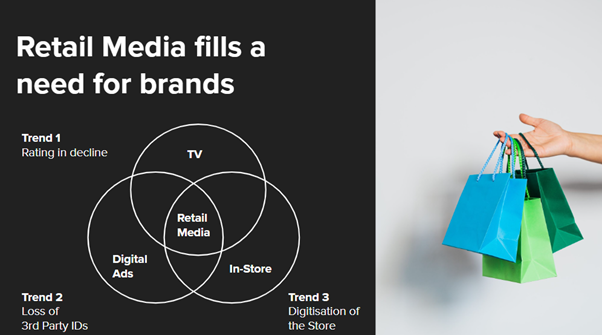Retail media is growing significantly and at WARC’s ‘Marketing in a fragmented media landscape’ webinar, Carousell Media Group shares the reasons behind it.
Read more
Retail media is growing and satisfying the requirements for brand reach and engagement, thanks to the explosion in OTT and connected TV, the loss of third-party identifiers, and the digitisation of stores.
A recently published WARC Marketing Toolkit report identified that one of the major themes affecting marketing in 2023 is the reckoning of big tech.
“This disruption is fundamentally reshaping our relationship with digital platforms,” said Rica Facundo, Asia Editor, WARC Strategy, APAC. She was speaking at WARC’s ‘Marketing in a fragmented media landscape’ webinar.
One of the implications is that brands today have more options to achieve their marketing objectives, one of which is the rise of retail media.
According to JJ Eastwood, Managing Director of Carousell Media Group, retail media will be a more than US$160 billion market by 2027, growing by over 60% from 2022.
He said, “Global commerce will make up 19% of retail sales in 2022 and grow to 25% by 2027.”
Aligned with this growth are future formats for platform targeting and programmatic. This suggests regional media is considering digital advertising with search functions revolving around social contexts that will reveal the buying intent consumers are searching for, he added.
There is also the ability to close the loop by knowing what consumers have bought, which gives end-to-end tracking. This will then make it extremely easy to serve ads that are contextually relevant and potentially reach these audiences at scale – very handy when monthly users easily spill into the tens of millions.
For example, Carousell records about 50 million monthly active users, while Amazon Walmart goes into the hundreds of billions, said Eastwood.
Retail media is starting to fill brands’ needs in reach and engagement. The first trend is a decline in traditional TV but an explosion in over-the-top and connected TV, said Eastwood. According to Industry Research & Insight (IAB) statistics, 78% of respondents plan to use off-platform targeting while 58% will jump onto programmatic ads.
The second is the loss of third-party identifiers. Marketers would have to adjust their advertising approach and test out new and less intrusive targeted advertising technologies. Indeed, the third highest number of respondents (61%) cited removal of third-party cookies as their biggest challenge for advertising. 91% also affirmed the task of formulating proper marketing outcomes measurements produced from these new technologies as the biggest challenge.
The third is the digitisation of stores. This is aligned with how media networks connect attributions from TV right through to in-store. The second highest number of respondents (73%) considered purchase data – omnichannel and in-store – as one of the four key features of retail media, while 55% feel attribution with measurement of metrics and KPIs is another key pillar.
“Retail media networks fall into three different classifications: digital marketplaces, mass merchant retailers, and commerce intermediaries or delivery providers,” said Eastwood.
With these, brands have been able to tap into purchase intent and serve ads that are directly related to what people are looking for. For example, Amazon’s website is filled with sponsored search ads, which are highly relevant and tailored to the preferences of consumers. The way its algorithm works is that the search is not limited to only the keyword term, which drives a much higher click-through rate because of those ads.
“Sponsored search ads make up 80%-plus of retail media networks revenue and Amazon’s share of search ad spend went from 13% in 2019 to 21% in 2022.”
The budgets in question hail from brand media and e-commerce media, which are consistently increasing. However, an additional layer is being compounded by shopper marketing and trade marketing budgets.
Non-endemic brands are now getting into the retail media game. There is increased use of shopping data to build audience personas. Just over a year from 2020–2021, 15% more non-endemics have engaged in retail media networks.
Retail media is also moving up the funnel into the browser, campaigns, display and video ads, working alongside activated products.
Eastwood said, “Most retailers are plugged into Google display and video, with Amazon DSP as another key player.”
Freelance journalist
Atalia Chua is a freelance journalist with close to nine years of experience in content creation and editorial strategy.
Please enter your feedback.
© Copyright Ascential Events (Europe) Limited 2022
Ascential Events (Europe) Limited
Americas: 229 West 43rd Street, 7th Floor, New York, NY 10036, United States – Tel: +1 212 201 2800
APAC: 5 Shenton Way, UIC Building #10-01, Singapore 068808 – Tel: +65 3157 6200
EMEA: 33 Kingsway, London, WC2B 6UF, United Kingdom – Tel: +44 (0)20 7467 8100
www.warc.com
All rights reserved including database rights. This electronic file is for the personal use of authorised users based at the subscribing company’s office location. It may not be reproduced, posted on intranets, extranets or the internet, e-mailed, archived or shared electronically either within the purchaser’s organisation or externally without express written permission from WARC.
© 2022 Copyright and Database Rights owned by Ascential Events (Europe) Limited
